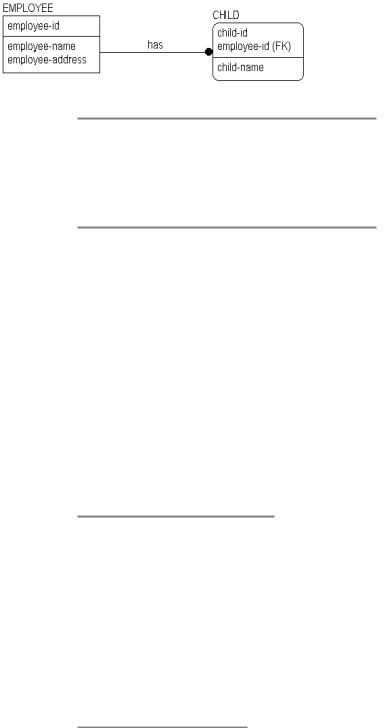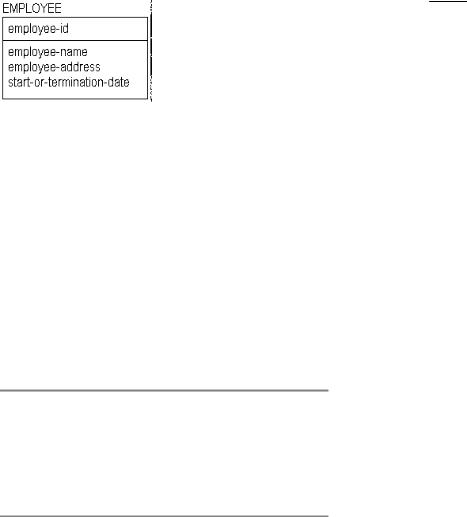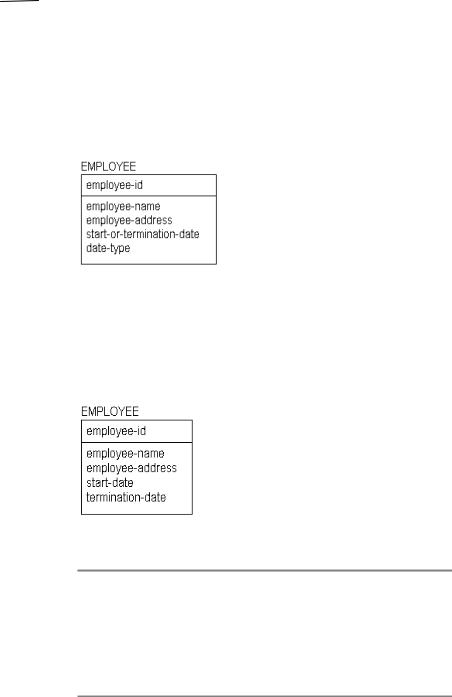
- •Contents
- •Preface
- •Intended Audience
- •About this Guide
- •Typographical Conventions
- •Related Documentation
- •What’s In This Chapter?
- •Chapter Contents
- •What is Data Modeling?
- •Data Modeling Sessions
- •Session Roles
- •Sample IDEF1X Modeling Methodology
- •Logical Models
- •The Entity Relationship Diagram
- •The Key-Based Model
- •The Fully-Attributed (FA) Model
- •Physical Models
- •The Transformation Model
- •The DBMS Model
- •Benefits of Modeling in ERwin
- •What’s In This Chapter?
- •Chapter Contents
- •The Entity-Relationship Diagram
- •Defining Entities and Attributes
- •Logical Relationships
- •Many-to-Many Relationships
- •Validating the Design of the Logical Model
- •Data Model Example
- •What’s In This Chapter?
- •Chapter Contents
- •Understanding Keys
- •Selecting a Primary Key
- •Designating Alternate Key Attributes
- •Inversion Entry Attributes
- •Relationships and Foreign Key Attributes
- •Dependent and Independent Entities
- •Identifying Relationships
- •Non-Identifying Relationships
- •Rolenames
- •What’s In This Chapter?
- •Chapter Contents
- •Naming Entities and Attributes
- •Synonyms, Homonyms and Aliases
- •Entity Definitions
- •Descriptions
- •Business Examples
- •Comments
- •Definition References and Circularity
- •Constructing a Business Glossary
- •Attribute Definitions
- •Rolenames
- •Definitions and Business Rules
- •What’s In This Chapter?
- •Chapter Contents
- •Relationship Cardinality
- •Cardinality in Non-Identifying Relationships
- •Referential Integrity
- •Reading Referential Integrity Options
- •RI, Cardinality, and Identifying Relationships
- •RI, Cardinality, and Non-Identifying Relationships
- •Additional Relationship Types
- •Many-to-Many Relationships
- •N-ary Relationships
- •Recursive Relationships
- •Subtype Relationships
- •Complete Versus Incomplete Subtype Structures
- •Inclusive and Exclusive Relationships
- •IDEF1X and IE Subtype Notation
- •When to Create a Subtype Relationship
- •Introduction
- •Chapter Contents
- •Overview of the Normal Forms
- •Functional Dependence (FD)
- •Full Functional Dependence
- •First Normal Form (1NF)
- •Second Normal Form (2NF)
- •Third Normal Form (3NF)
- •Common Design Problems
- •Repeating Data Groups
- •Multiple Use of the Same Attribute
- •Multiple Occurrences of the Same Fact
- •Conflicting Facts
- •Derived Attributes
- •Missing Information
- •Unification
- •How Much Normalization Is Enough?
- •Conclusions
- •ERwin Support for Normalization
- •First Normal Form Support
- •Second and Third Normal Form Support
- •What’s In This Chapter?
- •Chapter Contents
- •Creating a Physical Model
- •Denormalization
- •Classification of Dependent Entities
- •Glossary of Terms
- •Index
- •Documentation Comments Form

ERwin Methods Guide |
6 |
|
|
Common Design Problems
Many common design problems are a result of violating one of the normal forms. Common problems include:
♦Repeating data groups
♦Multiple use of the same attribute
♦Multiple occurrences of the same fact
♦Conflicting facts
♦Derived attributes
♦Missing information
These problems are examined individually in the follow sections, and explained using models and sample instance data. When you work on eliminating design problems, the use of sample instance data can be invaluable in discovering many normalization errors.
Repeating Data Groups
Repeating data groups can be defined as lists, repeating elements, or internal structures inside an attribute. This structure, although common in legacy data structures, violates first normal form and must be eliminated in an RDBMS model. This is because an RDBMS cannot handle variable-length repeating fields, because it offers no ability to subscript through arrays of this type. The entity below contains a repeating data group, “children’s-names”. Repeating data groups violate first normal form, which basically states that “An entity is in first normal form if each of its attributes has a single meaning and not more than one value for each instance.”
Repeating data groups, such as in the example below, present problems when defining a database to contain the actual data. For example, after designing the EMPLOYEE entity, you are faced with the questions “How many children’s names do we need to record?” “How much space should we leave in each row in the database for the names?” and “What will we do if we have more names than remaining space?”
EMPLOYEE Entity
Normalization ∙ 73

6 |
ERwin Methods Guide |
|
|
A sample instance table might clarify the problem:
EMPLOYEE
emp-id |
emp-name emp-address children's-names |
||
E1 |
Tom |
Berkeley |
Jane |
E2 |
Don |
Berkeley |
Tom, Dick, Donna |
E3 |
Bob |
Princeton |
— |
E4 |
John |
New York |
Lisa |
E5 |
Carol |
Berkeley |
— |
EMPLOYEE Sample Instance Table
In order to fix the design, we must somehow remove the list of children’s names from the EMPLOYEE entity. One way to do this is to add a CHILD table to contain the information about employee’s children. Once that is done, you can represent the names of the children as single entries in the CHILD table. In terms of the physical record structure for employee, this can resolve some of your questions about space allocation, and prevent wasting space in the record structure for employees who have no children or, conversely, deciding how much space to allocate for employees with families.
EMPLOYEE
emp-id emp-name |
emp-address |
||
E1 |
Tom |
Berkeley |
|
E2 |
Don |
Berkeley |
|
E3 |
Bob |
Princeton |
|
E4 |
Carol |
Berkeley |
|
|
|
|
|
CHILD |
|
|
|
|
|
|
|
emp-id child-id |
child-name |
|
E2 |
C1 |
Tom |
E2 |
C2 |
Dick |
E2 |
C3 |
Donna |
E4 |
C1 |
Lisa |
Sample Instance Tables for the EMPLOYEE-CHILD Model
74 ∙ Normalization

ERwin Methods Guide |
6 |
|
|
This change makes the first step toward a normalized model – conversion to first normal form. Both entities now contain only fixed-length fields, which are easy to understand and program.
Multiple Use of the Same Attribute
It is also a problem when a single attribute can represent one of two facts, and there is no way to understand which fact it represents. For example, the EMPLOYEE entity below contains the attribute “start-or-termination-date” in which you can record this information for an employee.
EMPLOYEE Entity with “Start-or-termination-date” Attribute
EMPLOYEE
emp-id emp-name |
emp-address |
start-or-termination-date |
|
E1 |
Tom |
Berkeley |
Jan 10. 1998 |
E2 |
Don |
Berkeley |
May 22, 1998 |
E3 |
Bob |
Princeton |
Mar 15, 1997 |
E4 |
John |
New York |
Sep 30, 1998 |
E5 |
Carol |
Berkeley |
Apr 22, 1994 |
E6 |
George |
Pittsburgh |
Oct 15, 1998 |
Sample Instance Table Showing “Start-or-termination-date”
The problem in the current design is that there is no way to record both a start date, “the date that the EMPLOYEE started work,” and a termination date, “the date on which an EMPLOYEE left the company,” in situations where both dates are known. This is because a single attribute represents two different facts. This is also a common structure in legacy COBOL systems, but one that often resulted in maintenance nightmares and misinterpretation of information.
Normalization ∙ 75

6 |
ERwin Methods Guide |
|
|
The solution is to allow separate attributes to carry separate facts. Below is an attempt to correct the problem. It’s still not quite right. To know the start date for an employee, for example, you have to derive what kind of date it is from the “date-type” attribute. While this may be efficient in terms of physical database space conservation, it wreaks havoc with query logic.
In fact, this “solution” actually creates a different type of normalization error, because “date-type” does not depend on “employee-id” for its existence. This is also poor design because it solves a technical problem, but does not solve the underlying business problem – how to store two facts about an employee.
When you analyze the data, you can quickly determine that a better solution is to let each attribute carry a separate fact.
EMPLOYEE Entity with “Start-date” and “Termination-date” Attributes
EMPLOYEE
emp-id emp-name |
emp-address |
start-date |
termination-date |
|
E1 |
Tom |
Berkeley |
Jan 10. 1998 |
— |
E2 |
Don |
Berkeley |
May 22, 1998 |
— |
E3 |
Bob |
Princeton |
Mar 15, 1997 |
— |
E4 |
John |
New York |
Sep 30, 1998 |
— |
E5 |
Carol |
Berkeley |
Apr 22, 1994 |
— |
E6 |
George |
Pittsburgh |
Oct 15, 1998 |
Nov 30, 1998 |
Sample Instance Table Showing “Start-date” and “Termination-date”
76 ∙ Normalization
